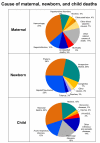Sub-Saharan Africa's mothers, newborns, and children: where and why do they die?
- PMID: 20574524
- PMCID: PMC2888581
- DOI: 10.1371/journal.pmed.1000294
Sub-Saharan Africa's mothers, newborns, and children: where and why do they die?
Abstract
In the first article in a series on maternal, newborn, and child health in sub-Saharan Africa, Joy Lawn and colleagues outline where and why deaths among mothers and children occur and what known interventions can be employed to prevent these deaths.
Conflict of interest statement
The authors have declared that no competing interests exist.
Figures







References
-
- UNICEF. State of the World's Children 2010. New York: UNICEF; 2009.
-
- Bryce J, Requejo JH, editors. Tracking Progress in Maternal, Newborn and Child Survival: The 2010 Report. New York: UNICEF; 2010. In press.
-
- Stanton C, Lawn JE, Rahman H, Wilczynska-Ketende K, Hill K. Stillbirth rates: delivering estimates in 190 countries. Lancet. 2006;367:1487–1494. - PubMed
-
- United Nations. The Millennium Development Goals Report 2009. New York: United Nations Department of Economic and Social Affairs; 2009.
Publication types
MeSH terms
LinkOut - more resources
Full Text Sources
Medical

